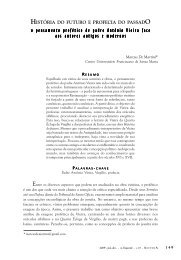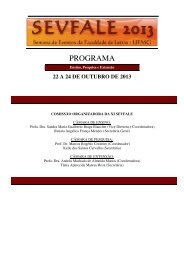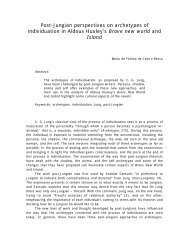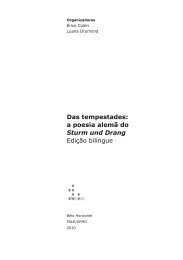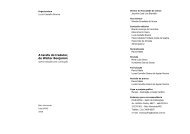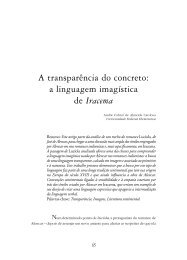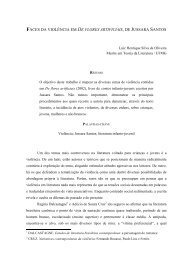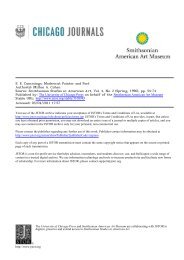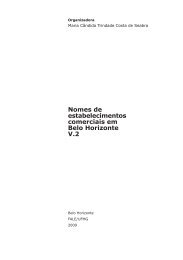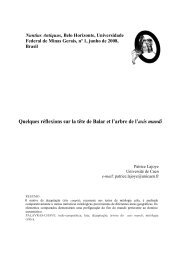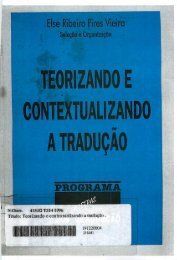Contornos do Indizível: o estilo de Clarice Lispector - Fale - UFMG
Contornos do Indizível: o estilo de Clarice Lispector - Fale - UFMG
Contornos do Indizível: o estilo de Clarice Lispector - Fale - UFMG
You also want an ePaper? Increase the reach of your titles
YUMPU automatically turns print PDFs into web optimized ePapers that Google loves.
60<br />
Em Tese, Belo Horizonte, v. 10, p. 60-66, <strong>de</strong>z. 2006<br />
Reinventing Cartography:<br />
Jhumpa Lahiri’s Interpreter of Maladies and The Namesake<br />
Abstract<br />
Disponível em http://www.letras.ufmg.br/poslit<br />
Daniela Cor<strong>de</strong>iro Soares Silva<br />
By taking Lahiri’s map imagery as a starting point, I reflect on<br />
the author’s portrayal of the Indian diaspora and the way she<br />
builds up a narrative that questions many of the ontological and<br />
solid beliefs established by hegemonic discourses, including the<br />
concepts of fixed i<strong>de</strong>ntities and gen<strong>de</strong>r roles.<br />
Key words: Diaspora. Postcolonialism. Maps. I<strong>de</strong>ntity. Gen<strong>de</strong>r.<br />
Maps are known to play an important role in the history of colonization,<br />
<strong>do</strong>mination and the making of the world, both visually and i<strong>de</strong>ologically speaking.<br />
When we turn to the history of maps, we can see that they are more than simply the<br />
representation on paper of the earth’s surface, and that in fact, they also act as textual<br />
inscriptions of power. They become, in a way, the scientific proof of what the<br />
geographer claims as territory. As José Rabasa explains, “[t]he written solidifies<br />
locations while supplying meaning to the visual” (Rabasa 361). Tiffin and Lawson (3)<br />
also study the relation of maps and power and they stress that if guns initiated<br />
imperial <strong>do</strong>mination was initiated by guns, they were maintained by textuality and, in<br />
this case, maps act as textual references to establish <strong>do</strong>mination. Therefore, to write<br />
or to draw a map means to have the power to supply, to fill the visual element with<br />
meanings. As part of the process of inscribing meanings onto a map, there is the<br />
attempt of hegemonic forces to create the illusion of distinct places occupied by<br />
homogeneous groups of people, an illusion that en<strong>do</strong>rses the notions of existing fixed<br />
and unified cultures and i<strong>de</strong>ntities.<br />
In a mapped world, the concepts of culture and i<strong>de</strong>ntity are often groun<strong>de</strong>d on<br />
the relation of subjects and the space they come to occupy, or the location of subjects<br />
on the map. The frozen picture of bor<strong>de</strong>rs on the surface of paper inspires a logical,<br />
natural, rigid and permanent organization of the world. These bor<strong>de</strong>rs bring the i<strong>de</strong>a<br />
that the world is precisely divi<strong>de</strong>d into homogeneous nations or groups of people<br />
sharing a common culture and i<strong>de</strong>ntity and separated from other groups, for instance,<br />
as Kipling states “East is East, and West is West, and never the twain shall meet”<br />
(190).<br />
The movements of the new diasporas in a postmo<strong>de</strong>rn world, which inclu<strong>de</strong>s the<br />
movements of postcolonial subjects, come to disturb the organization of the maps<br />
imposed by hegemonic discourses and to bring inconsistency to the rigid notions of



